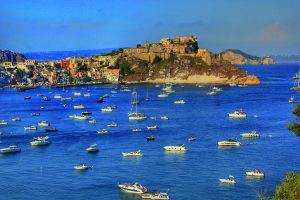 Un’isola fuori dal tempo, caratterizzata dal contesto di barche di pescatori e piccoli borghi arroccati sulle colline. È come si presenta Procida, la più piccola delle isole del Golfo di Napoli con 3,7 kmq di superfice. La sua è una bellezza tipicamente mediterranea, esaltata dalla letteratura al cinema, che l’ha resa protagonista di tante opere. Alla fine degli anni ‘50 Elsa Morante le dedicò il libro “L’isola di Arturo”.
Un’isola fuori dal tempo, caratterizzata dal contesto di barche di pescatori e piccoli borghi arroccati sulle colline. È come si presenta Procida, la più piccola delle isole del Golfo di Napoli con 3,7 kmq di superfice. La sua è una bellezza tipicamente mediterranea, esaltata dalla letteratura al cinema, che l’ha resa protagonista di tante opere. Alla fine degli anni ‘50 Elsa Morante le dedicò il libro “L’isola di Arturo”.
È la regina del “turismo lento”: infatti, secondo gli esperti, va scoperta con calma. Propone un perfetto mix tra bellezze naturalistiche, scorci dalla lunga storia e spiagge imperdibili. Si può girare facilmente a piedi, ma anche utilizzare bus o taxi. Presenta un interessante porto, Marina Grande: “Ormeggiare nella Marina di Procida – si legge sui portali specializzati – significa accedere a un mondo fatto di colori vibranti, panorami mozzafiato e autentica bellezza mediterranea. Situata tra Ischia e Capo Miseno, la marina offre ogni comfort per il diportista e un facile collegamento con la terraferma tramite traghetti e aliscafi”.
Il territorio di Procida è diviso in nove contrade, dette grancìe: Terra Murata (la più antica), Corricella (il borgo di pescatori), Sent’cò (con il porto commerciale di Marina Grande), Semmarezio, San Leonardo, Madonna della Libera (o Santissima Annunziata), Sant’Antuono, Sant’Antonio e Chiaiolella (dove c’è un porto turistico).
La parte storica è rappresentata dal borgo di Terra Murata, il cuore dell’isola, ma altrettanto interessante è l’isoletta di Vivara, collegata a Procida tramite un ponte. Si può visitare anche in un solo giorno, l’importante è pianificare gli spostamenti o, in alternativa, lasciarsi andare all’istinto o alle dritte dei residenti. A Marina Grande si trova il porto, nucleo del centro diviso tra negozi di artigianato, bar, piccole boutique e punti di noleggio per motorini, biciclette, minicar e imbarcazioni varie. Da qui ci si può spostare verso il centro storico, salendo da via Principe Umberto fino a piazza dei Martiri, passando dal santuario di Santa Maria delle Grazie e fermandosi al belvedere dei cannoni per osservare Marina Corricella. Terra Murata è l’antico centro storico. Qui si può visitare il Palazzo D’Avalos, che fu reggia e carcere, fino a giungere all’Abbazia di San Michele Arcangelo (XI secolo).
Fra le spiagge, una delle più caratteristiche è quella del Pozzo Vecchio, posta sul versante occidentale e resa famosa perché furono girare nel 1994 scene iconiche de “Il Postino”, l’ultimo film di Massimo Troisi.
Procida, enchantment in the Gulf of Naples
An island out of time, characterized by the context of fishing boats and small villages perched on the hills. This is how Procida presents itself, the smallest of the islands in the gulf of Naples with a surface area of 3.7 sq km. Its beauty is typically mediterranean, exalted by literature and cinema, which have made it the protagonist of many works.
In the late 1950s, Elsa Morante dedicated the book “Arturo’s Island” to it.
It is the queen of “slow tourism”: in fact, according to experts, it should be discovered calmly. It offers a perfect mix of natural beauty, views with a long history, and unmissable beaches. It can be easily explored on foot, but also by bus or taxi. It has an interesting port, marina grande: “mooring in the marina di Procida – as stated on specialized portals – means accessing a world of vibrant colors, breathtaking views, and authentic mediterranean beauty. located between Ischia and Capo Miseno, the marina offers every comfort for boaters and easy connections to the mainland via ferries and hydrofoils.”
The territory of Procida is divided into nine districts, called “grancìe”: Terra Murata (the oldest), Corricella (the fishing village), Sent’cò (with the commercial port of marina grande), Semmarezio, San Leonardo, Madonna della libera (or Santissima Annunziata), Sant’Antuono, Sant’Antonio, and Chiaiolella (where there is a tourist port). The historical part is represented by the village of Terra murata, the heart of the island, but equally interesting is the islet of vivara, connected to Procida by a bridge. It can be visited even in a single day; the important thing is to plan your movements or, alternatively, let yourself beguided by instinct or by the advice of residents.
In Marina Grande, you will find the port, the nucleus of the center divided between craft shops, bars, small boutiques, and rental points for scooters, bicycles, minicars, and various boats. From here you can move towards the historic center, going up via Principe umberto to Piazza dei martiri, passing the sanctuary of Santa maria delle grazie and stopping at the “belvedere dei cannoni” (cannons’ viewpoint) to observe marina Corricella. Terra murata is the ancient historic center. here you can visit Palazzo d’Avalos, which was a royal palace and a prison, up to the Abbey of San michele Arcangelo (11th century).
Among the beaches, one of the most characteristic is Pozzo vecchio, located on the western side and made famous because iconic scenes from “Il Postino” (The Postman), Massimo Troisi’s last film, were shot there in 1994.

 English
English










